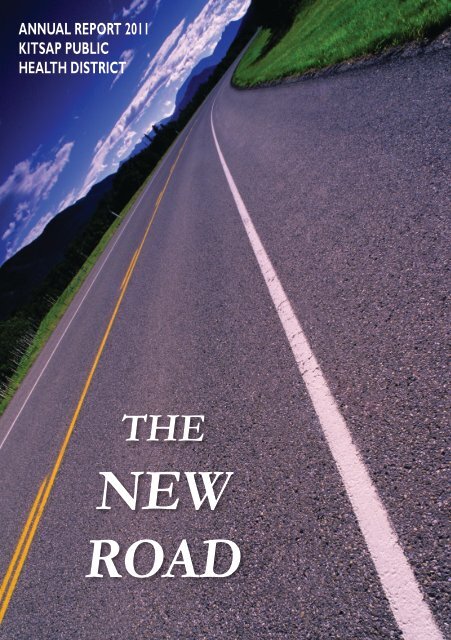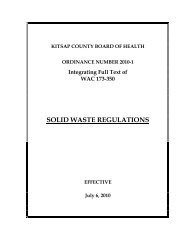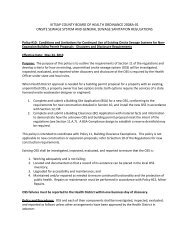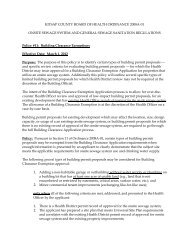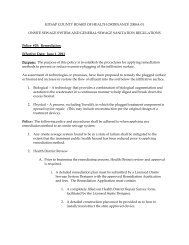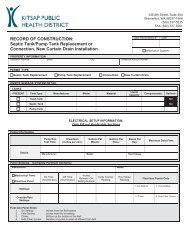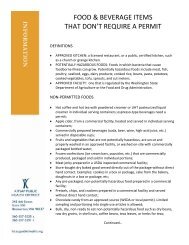ANNUAL REPORT 2011 KITSAP PUBLIC HEALTH DISTRICT
ANNUAL REPORT 2011 KITSAP PUBLIC HEALTH DISTRICT
ANNUAL REPORT 2011 KITSAP PUBLIC HEALTH DISTRICT
Create successful ePaper yourself
Turn your PDF publications into a flip-book with our unique Google optimized e-Paper software.
<strong>ANNUAL</strong> <strong>REPORT</strong> <strong>2011</strong><br />
<strong>KITSAP</strong> <strong>PUBLIC</strong><br />
<strong>HEALTH</strong> <strong>DISTRICT</strong><br />
THE<br />
NEW<br />
ROAD
THE NEW RO<br />
PREVENTION IS <strong>PUBLIC</strong> <strong>HEALTH</strong><br />
<strong>2011</strong> was another down year for the economy. To us in public health,<br />
that means even greater stresses on the health of our community. That’s<br />
because economic and social conditions are the true drivers of health.<br />
Research shows that social conditions – the jobs we do, the schools we<br />
attend, the neighborhoods we live in – are as important to our health as<br />
our genes, our behaviors, and even our medical care.<br />
Public health has made great strides in combating infectious diseases<br />
and improving sanitation, but we’re increasingly dying early from<br />
preventable causes following years of illness and disability. Chronic<br />
diseases such as diabetes and heart disease --- resulting from tobacco<br />
use, poor nutrition, physical inactivity, and other underlying causes --- are<br />
not only cutting lives short, they are also greatly increasing our medical<br />
spending. We can do better.<br />
Health will improve most by preventing disease in the first place<br />
rather than treating it after it’s occurred. This is the theme of public<br />
health.<br />
“Health will<br />
improve most<br />
by preventing<br />
disease in the<br />
first place<br />
rather than<br />
treating it after<br />
it’s occurred.”<br />
To respond, we must build a public health system that recognizes<br />
health disparities, helps people adopt healthy behaviors, and assists<br />
organizations and communities in encouraging healthier lifestyles. It also<br />
requires that we help decision makers implement policies based on the<br />
best available evidence to improve the conditions in which we all live.<br />
As discussed in this report, our Strategic Plan and the Kitsap<br />
Community Health Priorities Plan, both completed in <strong>2011</strong>, address<br />
these new realities and strive to improve age-old public health<br />
responsibilities. The future identified in these plans requires that we use<br />
our limited resources more efficiently and effectively. It also requires<br />
that we forge new partnerships, and use technology smarter. By doing<br />
this, we can shape a more effective public health system, and improve the<br />
health of everyone in Kitsap County.<br />
I would like to extend a sincere thank-you to all our staff at the Kitsap<br />
Public Health District for their hard work on strategic planning and the<br />
establishment of Kitsap County Health Priorities. The dedication of our<br />
staff in this time of change has been an inspiration for me. I sometimes<br />
hear less than favorable comments about public workers, but having<br />
worked in both private practice and public health, I have never seen<br />
people work as hard as the staff of the Kitsap Public Health District.<br />
Sincerely,<br />
Scott Lindquist, MD, MPH<br />
Director of Health
AD THE NEW<br />
STRATEGIC PLANNING<br />
At no time in the District’s history has the need for strategic planning been more critical. Our<br />
financial resources will remain limited for some time requiring us to prioritize their highest and best<br />
use. In <strong>2011</strong>, we completed a formal 10-year strategic planning process to do just that.<br />
Our planning team --- composed of District staff, the District’s Board Chair, and a Health Officer<br />
of a sister county health department --- met over seven months to craft our plan. Prior to making<br />
decisions, we reviewed data describing the current and future environment for public health and<br />
surveyed our staff and community stakeholders about their priorities for our work and their<br />
assessment of our performance.<br />
The following Guiding Principles informed our work:<br />
• Prevention: Prevention is the most effective way to protect our community from disease and<br />
injury.<br />
• Partnerships: Work with others when collaboration will produce better and faster results.<br />
• Effectiveness: Data-driven decisions and science-based practices produce the best outcomes.<br />
• Equity: All Kitsap residents should have an equal opportunity to live healthy and safe lives.<br />
• Quality: Continuously improving the quality of our services and systems will better serve our<br />
community.<br />
The <strong>2011</strong>-2021 Strategic Plan represents our<br />
public commitment to address the most pressing<br />
public health needs in our community. To ensure<br />
our success, we’re also developing a performance<br />
monitoring and reporting system, and a continuous<br />
quality improvement process. This will ensure good<br />
stewardship of the resources entrusted to us, and<br />
allow us to demonstrate our accountability to the<br />
community we serve.<br />
Our Strategic Plan contains the following<br />
major goals:<br />
• Strengthen our ability to prevent and control<br />
communicable diseases.<br />
• Decrease chronic diseases and their impacts in our community.<br />
• Prevent and reduce environmental threats to public health from contaminated water, food,<br />
land, and air.<br />
• Promote healthy child development and health equity by ensuring all children have healthy<br />
starts.<br />
• Strengthen our financial and technological resources and ensure our workforce has the new<br />
skills required in our changing environment.<br />
The complete plan is available on the “About” page of our website at kitsappublichealth.org.
<strong>2011</strong> Revenues<br />
<strong>KITSAP</strong> COMMUNITY <strong>HEALTH</strong> PRIORITIES:<br />
A shared vision of community health<br />
Health is determined not only by health care, individual<br />
behaviors, and genetics, but also by the social, economic, and<br />
environmental conditions in which we live. To truly improve<br />
the health of the community, these factors must be addressed<br />
by everyone who has an interest in health --- quite simply, by<br />
all of us.<br />
“Any town that<br />
doesn’t have<br />
sidewalks doesn’t<br />
love its children.”<br />
Margaret Mead<br />
The Kitsap Community Health Priorities (KCHP) process<br />
was initiated to bring diverse community groups together<br />
in a united effort to improve the health and well-being of<br />
all residents of Kitsap County. The KCHP process involved<br />
broad participation to set community health priorities, take<br />
action on those priorities, and celebrate progress.<br />
In late 2010, the KCHP Planning Phase was spearheaded<br />
by Bob Cross, Executive Director of Strategic Planning for<br />
Harrison Medical Center; Dave Foote, Executive Director of<br />
United Way Kitsap; and Scott Lindquist, Director and Health<br />
Officer of the Kitsap Public Health District. In <strong>2011</strong>, this<br />
“Sponsor Group” engaged a cross section of leaders from<br />
community organizations --- called the “Charter Group”<br />
--- to evaluate data on the health status of County residents<br />
and use the data to identify potential health priorities.<br />
Establishing meaningful community health priorities, and<br />
involving the community in the work, is critical to achieve<br />
success. Other community representatives joined the KCHP<br />
process in May <strong>2011</strong>.<br />
In a series of three meetings, community representative<br />
attendees 1) provided data and perceptions about local<br />
factors affecting the health and well-being of Kitsap County<br />
residents, 2) reviewed potential health priorities, and 3)<br />
selected the final health priorities. Four of the five final<br />
Community Health Priorities are being addressed by<br />
community member Working Groups as part of the Action<br />
Phase that began in 2012.<br />
KCHP COMMUNITY PARTNERS<br />
KCHP is lead by a three-member Sponsor Group:<br />
• Harrison Medical Center<br />
• United Way Kitsap<br />
• Kitsap Public Health District<br />
The Community<br />
Health Priorities for<br />
Kitsap County are:<br />
• Ensure access to affordable<br />
medical, behavioral health,<br />
and dental care to all<br />
residents.<br />
• Make it easy for residents<br />
to be physically active.<br />
• Ensure all residents have<br />
healthier food options.<br />
• Ensure all children and<br />
youth receive the support<br />
necessary to be healthy<br />
throughout life.<br />
• Promote economic<br />
development that provides<br />
living wage jobs with<br />
benefits. [This priority is<br />
being addressed by other<br />
groups in the County.]<br />
The following KCHP Charter Group provided additional in-depth evaluation of community health data:<br />
• City of Bremerton<br />
• Holly Ridge Center<br />
• Housing Kitsap<br />
• Kitsap Community Resources<br />
• Kitsap Mental Health Services<br />
• Kitsap Regional Coordinating Council<br />
• Olympic Educational Service District<br />
• Peninsula Community Health Services<br />
• Washington State Department of Social and<br />
Health Services
FINANCIAL DATA <strong>2011</strong><br />
Revenues<br />
Contracts & Grants<br />
$4,768,684<br />
49.7%<br />
Fees<br />
$2,901,959<br />
30.2%<br />
Local<br />
Government<br />
$1,383,800<br />
14.4%<br />
State Public Health<br />
Assistance Funds<br />
$515,449<br />
5.4%<br />
Miscellaneous<br />
$27,983<br />
0.3%<br />
Supplies<br />
$313,283<br />
3.3%<br />
Expenses<br />
Wages & Benefits<br />
$7,336,611<br />
77.2%<br />
Professional Services<br />
$629,553<br />
6.6%<br />
Other Operating Costs<br />
$579,952<br />
6.1%<br />
Facility Costs<br />
$587,169<br />
6.2%<br />
Capital Equipment/<br />
Improvement<br />
$63,202<br />
0.6%<br />
<strong>2011</strong> 2010 2009 2008 2007<br />
<strong>KITSAP</strong> <strong>PUBLIC</strong><br />
<strong>HEALTH</strong> <strong>DISTRICT</strong><br />
EMPLOYEES<br />
(FULL-TIME<br />
EQUIVALENTS)<br />
ENVIRONMENTAL <strong>HEALTH</strong><br />
COMMUNITY <strong>HEALTH</strong><br />
ADMINISTRATION<br />
37<br />
23<br />
27<br />
38<br />
25<br />
26<br />
41<br />
31<br />
30<br />
39<br />
32<br />
33<br />
46<br />
44<br />
36<br />
TOTAL<br />
87<br />
89<br />
102<br />
104<br />
126<br />
“Old Manette Bridge,” background photograph by Michael Drew
ROAD<br />
CHRONIC DISEASE:<br />
The public health challenge of the 21st Century<br />
Both the District’s<br />
Strategic Plan and the<br />
Kitsap Community<br />
Health Priorities include<br />
an expansive strategic<br />
goal that will require<br />
a complete change in<br />
community norms, and a<br />
tremendous effort on the<br />
part of the District and<br />
its community partners:<br />
the prevention of chronic<br />
diseases.<br />
Chronic diseases—such as heart disease, cancer, and diabetes—<br />
are the leading causes of death and disability in the United States.<br />
Almost 1 out of every 2 adults has at least one chronic illness.<br />
Four modifiable behaviors—lack of physical activity, poor nutrition,<br />
tobacco use, and excessive alcohol consumption—are responsible<br />
for much of the illness, suffering, and early death related to chronic<br />
diseases.<br />
“The best way<br />
to predict<br />
the future is to<br />
create it.”<br />
Peter F. Drucker<br />
Over the past few decades, we have witnessed a steep rise in<br />
obesity, a risk condition that leads to chronic illness, in both adults<br />
and children. In Kitsap County, approximately 60% of all adults are<br />
either overweight or obese, a staggering statistic.<br />
Additionally, the U.S. spends significantly more on health care than<br />
any other nation on the planet, yet our average life expectancy is far<br />
below many other nations that spend less on health care. Chronic<br />
disease accounts for approximately 70% of these U.S. health care<br />
costs, yet we invest only 1% of health spending on prevention, a<br />
paltry sum.<br />
Adopting healthy behaviors is much easier if we establish<br />
supportive community norms and adopt a philosophy that embraces<br />
health in all policies and settings. We must promote community-wide<br />
approaches that support healthy living for individuals, families, and<br />
communities.<br />
Background photograph by Michael Drew
OUR PROGRAMS <strong>2011</strong><br />
Clinical Services<br />
We assure people have<br />
access to immunizations<br />
and reproductive health<br />
care services, and we<br />
monitor and control<br />
communicable diseases.<br />
Epidemiology and<br />
Assessment<br />
We collect, analyze, and<br />
report a wide range of<br />
data to ensure that our<br />
services are based on an<br />
accurate understanding of<br />
the county’s health status<br />
and needs.<br />
Living Environment<br />
We monitor safety at<br />
water recreation facilities,<br />
schools, and camps. We<br />
enforce smoking in public<br />
places laws. We provide<br />
education about mold and<br />
indoor air quality.<br />
Public Health<br />
Emergency<br />
Preparedness and<br />
Response<br />
We work with community<br />
partners to plan and<br />
coordinate emergency<br />
preparedness and response<br />
activities in the event of a<br />
public health emergency.<br />
“Cooperation is the thorough conviction that nobody can<br />
get there unless everybody gets there.”<br />
Virginia Burden<br />
Food Safety<br />
We lower the incidence<br />
of food borne illnesses<br />
through inspections at food<br />
service establishments and<br />
provide training on safe<br />
food handling to all food<br />
service workers.<br />
Health Promotion<br />
We develop and implement<br />
outreach and education<br />
that help people make<br />
healthy and safe lifestyle<br />
choices.<br />
HIV/AIDS<br />
We assure that HIV/AIDS<br />
preventative, diagnostic,<br />
case management, and<br />
treatment services are<br />
available.<br />
Juvenile Detention<br />
Adolescent Health<br />
We provide health care<br />
services to young people at<br />
the Kitsap County Juvenile<br />
Detention Facility.<br />
Onsite Sewage<br />
We ensure that onsite<br />
septic systems are<br />
designed, installed,<br />
operated, and maintained<br />
properly.<br />
Parent Child Health<br />
We promote the health of<br />
families, pregnant women,<br />
infants, children, and<br />
children with special health<br />
care needs.<br />
Pollution Identification<br />
and Correction<br />
We monitor and improve<br />
lake, stream, and shoreline<br />
water quality to protect<br />
you from waterborne<br />
illnesses and contaminated<br />
shellfish.<br />
Solid and Hazardous<br />
Waste<br />
We protect public health<br />
by ensuring proper<br />
management of solid and<br />
hazardous wastes through<br />
effective permitting,<br />
enforcement and education<br />
and outreach. With other<br />
stakeholders, we promote<br />
pollution prevention, waste<br />
minimization, reuse, and<br />
recycling.<br />
Drinking Water<br />
We ensure reliable<br />
quantity and quality for<br />
drinking water sources.
<strong>2011</strong> <strong>KITSAP</strong><br />
<strong>PUBLIC</strong> <strong>HEALTH</strong> BOARD<br />
Charlotte Garrido<br />
Chair<br />
Commissioner, Kitsap County<br />
Becky Erickson<br />
Vice-Chair<br />
Mayor, City of Poulsbo<br />
Steve Bauer<br />
Commissioner,<br />
Kitsap County (January – March)<br />
Josh Brown<br />
Commissioner, Kitsap County<br />
Lary Coppola<br />
Mayor, City of Port Orchard<br />
Rob Gelder<br />
Commissioner,<br />
Kitsap County (April – December)<br />
Kirsten Hytopoulos<br />
Council Member,<br />
City of Bainbridge Island<br />
Patty Lent<br />
Mayor, City of Bremerton<br />
Roy Runyon (alternate)<br />
Council Member, City of Bremerton<br />
Striving to make Kitsap County a healthy and safe place to live, learn, work, and play.<br />
345 6th Street, Suite 300 • Bremerton, WA 98337<br />
Phone: (360) 337-5235 • Fax: (360) 337-5298 • kitsappublichealth.org<br />
The Kitsap Public Health District does not discriminate on the basis of race, color, national origin, disability, sex, age,<br />
religion, marital status, veteran status, or sexual orientation.


